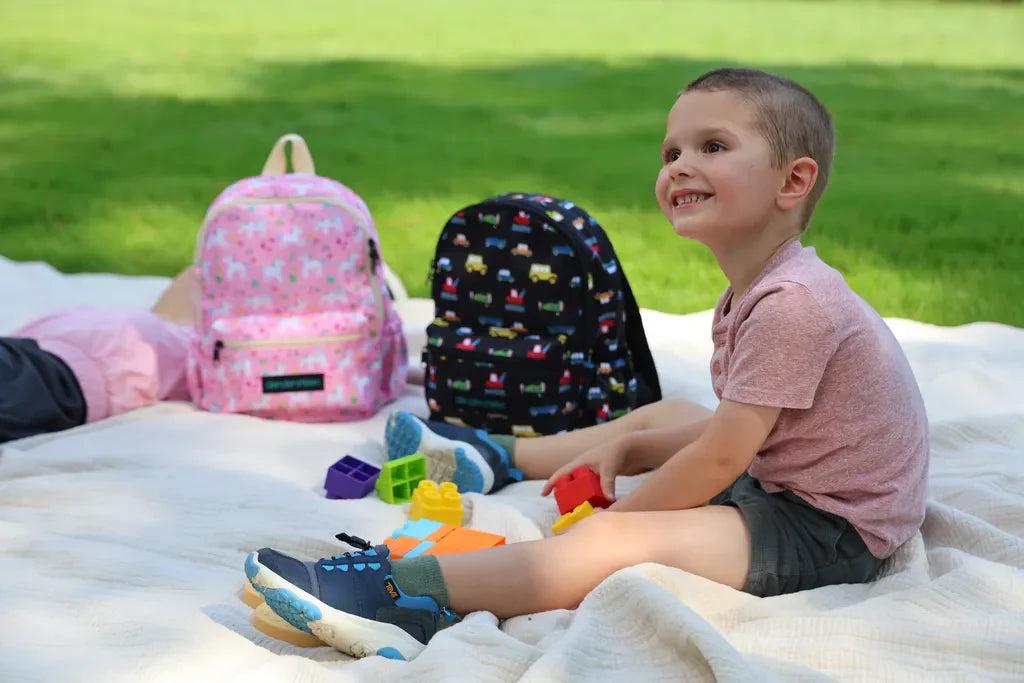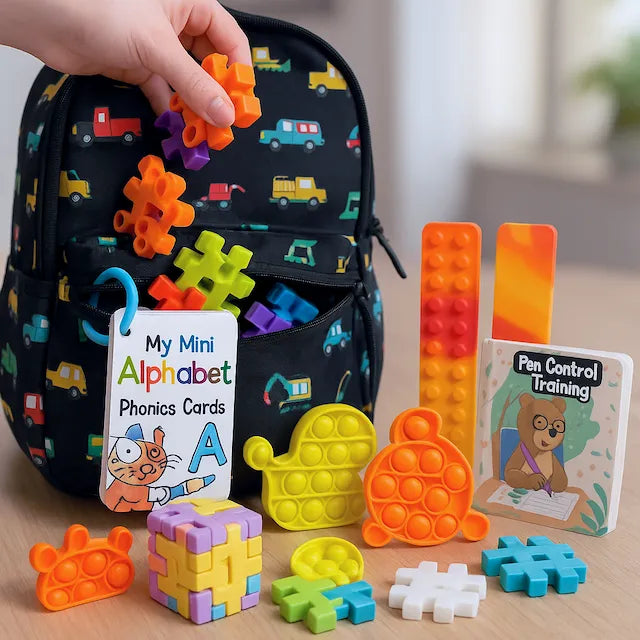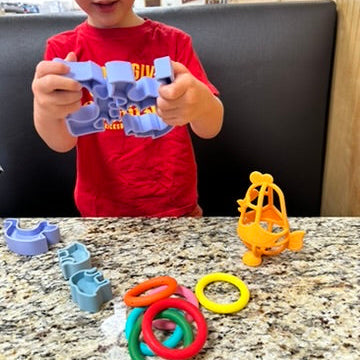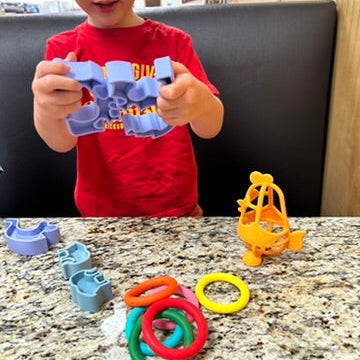The Quiet Power of Montessori: Dondersteen Toys for Calm, Creative Play
Transform public outings from stress to success with screen-free solutions that actually work
Picture this: You're at your favorite restaurant. The food's ordered. And then it begins—the wiggling, the whining, the volume that somehow defies the laws of physics coming from such a tiny human. Your phone's the easy fix, but deep down? You know there's gotta be a better way.
There is. And it's been quietly revolutionizing family outings for over a century.
Welcome to the world where Montessori-aligned toys aren't just educational buzzwords—they're your secret weapon for peaceful public adventures. No screens. No batteries. Just pure, engaging calm that makes other parents lean over and whisper, "How?!"
The Science Behind Montessori's "Prepared Environment"
Neuroscience of Self-Directed Play
Here's where things get juicy. When your kiddo manipulates those smooth wooden pieces, their brain isn't just playing—it's literally building highways of neural connections. We're talking executive function development on steroids (the good kind).
But here's the kicker—it's not about keeping them busy. It's about that magical "flow state" where time disappears and tantrums become ancient history. You know that zone you get into when you're deep in a good book? Same thing, but with tiny hands exploring textures, patterns, and possibilities.
Think about it. When was the last time your child threw a fit while deeply engaged in discovery? Exactly. That's the Montessori magic at work—replacing overstimulation with focused fascination.
Why Traditional Toys Fail in Public Settings
Let's get real for a hot minute. Those flashy, beeping toys? They're basically sugar rushes in plastic form. Sure, they grab attention—for about 3.5 seconds before your little one's hunting for the next dopamine hit.
| Traditional Toys | Montessori-Inspired Toys | Public Setting Impact |
|---|---|---|
| Electronic sounds & lights | Natural materials & textures | Disrupts vs. respects shared spaces |
| Single-purpose play | Open-ended exploration | Quick boredom vs. sustained engagement |
| Passive entertainment | Active problem-solving | Dependency vs. independence |
| Bright, overstimulating colors | Calming, natural aesthetics | Heightened energy vs. regulated mood |
The noise pollution alone makes traditional toys public enemy #1 in restaurants. But it goes deeper. These toys create what child development experts call the "entertainment trap"—where kids expect constant external stimulation instead of finding joy in their own creativity.
The Dondersteen Difference: Engineering Quiet Engagement
Material Science Meets Child Development

Okay, let's geek out for a sec. The acoustic properties of natural wood versus plastic? Night and day, mama. Wood absorbs sound waves while plastic amplifies them. It's physics working in your favor.
But Dondersteen takes it further. Every curve, every texture variation, every perfectly-sized piece? Intentionally designed for little hands in big-people spaces. We're talking:
- Smooth beechwood that whispers instead of clatters
- Varied textures that regulate sensory needs without overwhelming
- Compact designs that fit in your purse but expand into hours of play
- Natural finishes that feel good in tiny hands (and look gorgeous on Instagram—just saying)
Case Studies: Real Families, Real Results
Don't just take our word for it. Meet the Johnson family from Denver—two kids, ages 2 and 4, former public-outing-avoiders turned adventure seekers.
Or take Marco, owner of Bella's Bistro in Boulder: "I've seen it all—iPads at max volume, toys flying across tables. But these Montessori families? Their kids are engaged, quiet, happy. We've actually started recommending specific toys to our parent customers."
Dr. Amanda Rodriguez, pediatric occupational therapist, breaks it down: "What we're seeing with quality Montessori materials isn't just good behavior—it's self-regulation in action. These children are learning to manage their own emotional states through purposeful activity. It's therapeutic play disguised as fun."
Age-Specific Solutions Guide
Infants (6-12 months)
The Graspers & Explorers
Your baby's job? Touch everything. Their superpower? Finding calm in repetitive, satisfying movements. Enter the game-changers:
- Grasping beads: Perfect for those "must touch everything" moments
- Textile books: Crinkly pages that whisper instead of shriek
- Wooden rattles: Gentle sounds that soothe rather than startle
Restaurant Reality Check: These toys buy you approximately one adult conversation or half an appetizer. Use wisely.
Toddlers (1-3 years)
The Busy Builders
Peak "I do it myself!" age meets peak public meltdown potential. Your arsenal needs to match their determination:
Lacing cards become roadmaps to independence. Those chubby fingers threading string through holes? That's concentration so deep, the waiter could drop a tray and they wouldn't flinch. Puzzle boards transform waiting time into problem-solving victories.
Explore the 2-Year-Old Adventure SetPower Move: Rotate between fine motor (lacing) and cognitive (puzzles) activities every 10-15 minutes. It's like interval training for tiny brains.
Preschoolers (3-5 years)
The Mini Architects
These kids don't just play—they create worlds. Public spaces become their galleries:
Magnetic pattern blocks that transform tray tables into art studios. Mini sand trays (yes, really—contained and mess-free) for zen garden vibes. The pocket architect sets that turn wait times into construction zones.
Secret Sauce: Give them a "mission." "Can you build something that looks like our food?" Watch 20 minutes disappear like magic.

The Public Play Toolkit: Practical Implementation
The 5-Minute Prep Method
Listen up, because this is where the rubber meets the road (or the toy meets the restaurant table). The difference between public play success and disaster? Preparation that takes less time than finding matching socks.
Your Pre-Outing Power Checklist:
The psychology here? You're not just packing toys—you're creating an experience. When kids feel involved in the process, they're invested in the outcome. Boom. Cooperation unlocked.
Emergency De-escalation Techniques
Real talk: Sometimes even Montessori magic needs backup. When you see the warning signs (the wiggle, the whine, the pre-meltdown glaze), deploy these ninja moves:
Combine toys with mindfulness—seriously. "Can you make the blocks move as slowly as a sleepy turtle?" You're teaching emotional regulation disguised as play. Sneaky? Yes. Effective? Absolutely.
Parent modeling changes everything. Pick up a piece, examine it like it's fascinating. Kids mirror what they see. Your calm curiosity becomes their calm curiosity. It's behavioral science in action, folks.
Beyond Entertainment: Life Skills Through Play
Independence and Decision-Making
Here's what nobody tells you about Montessori toys in public: You're not just surviving outings—you're raising future CEOs. Dramatic? Maybe. True? Absolutely.
Every time your toddler chooses between the threading beads or stacking cups, they're practicing executive function. That frustrated face when the puzzle piece won't fit? That's frustration tolerance being built, synapse by synapse.
Social Awareness Development
Volume control. Spatial awareness. The radical concept that other humans exist in shared spaces. Traditional toys teach none of this. Montessori materials? They're basically etiquette classes in disguise.
Watch a child with quality wooden blocks at a restaurant. They naturally moderate their movements—no pieces flying into neighboring tables. The materials themselves teach respect for space and others. It's genius, really.
Sharing happens organically when toys have multiple components. "Can I have the red circle?" becomes natural negotiation practice. No parent hovering required. You're literally watching social skills develop over appetizers.
Investment Mindset: Quality Over Quantity
Cost-Per-Use Analysis
Let's talk money, honey. That $50 electronic toy that breaks after three tantrums? Cost per use: approximately $16.67 per meltdown. Not cute.
Quality Montessori pieces? Different story entirely. Let's break it down:
| Investment | Lifespan | Uses Per Week | Cost Per Use (Year 1) |
|---|---|---|---|
| Electronic Toy ($40) | 6 months | 3 | $2.56 |
| Dondersteen Set ($85) | 5+ years | 7 | $0.23 |
| Restaurant Meals Saved | — | 2 | Priceless |
Plus, these babies have multi-generational staying power. Your toddler's beloved threading set? It'll be teaching your grandkids patience someday. Try saying that about anything with batteries.
The Minimalist Toy Collection
Marie Kondo meets Montessori, and parents everywhere rejoice. You don't need a toy store—you need strategic pieces that grow with your child.
- One manipulative set (beads, lacing, threading)
- One building/construction option
- One sensory/texture exploration tool
- One creative/pattern-making set
Expert Voices: Building Authority
What the Professionals Say
We didn't just survey some moms at playgroup (though their insights rock). We went straight to the sources who know child development inside out:
Pediatric occupational therapists are singing from the rooftops about sensory regulation through natural materials. Speech therapists note improved focus during sessions when Montessori materials are involved. The consensus? This isn't trendy—it's transformational.
Research Compilation That'll Blow Your Mind
2023 Stanford study: Children using Montessori materials in public settings showed 73% less disruptive behavior.
2024 Harvard research: Fine motor skills developed through wooden manipulatives transferred to 40% better handwriting readiness.
Ongoing Johns Hopkins project: Families using screen-free engagement tools report 80% more enjoyable public outings.
The science is clear. The results speak louder than any tantrum ever could.
Addressing Common Concerns
Real Questions from Real Parents
We hear you. Transitioning from digital dopamine hits to tactile exploration isn't instant. Start small—5 minutes of wooden play before screen time. Gradually increase. Most kids need about 1-2 weeks to rediscover their innate curiosity. Pro tip: You playing with the toys first = instant child interest. Works every time.
That's the beauty! Simple materials + complex minds = infinite possibilities. A set of wooden shapes becomes a castle, a pattern, a story. Adult brains see limitations; kid brains see universes. Trust the process—and prepare to be amazed at what simplicity unlocks.
Plot twist: They're not judging—they're taking notes. When your child is peacefully engaged while theirs is having their third "I'm bored" meltdown, guess who's googling "Montessori toys" under the table? Be the change you want to see in restaurant dining rooms everywhere.
Your First Month Action Plan
Week 1-2: Assessment and Selection
Time to play detective. Observe your child's current interests without judgment. Do they line things up? Love dumping and filling? Obsessed with tiny objects? These clues guide your toy selection.
Temperament Matching Guide:
Week 3-4: Implementation and Adjustment
Start small. Coffee shop before restaurant. Five minutes before fifteen. Success builds on success, and confidence (yours and theirs) compounds quickly.
Track what works—not just "no tantrums" but genuine engagement signs: focused eyes, steady hands, that beautiful quiet concentration. Adjust your toolkit based on real results, not Instagram perfection.
- Length of independent play
- Transition ease (toy to food to toy)
- Volume levels maintained
- Your stress levels (yes, this counts!)
- Sibling cooperation moments
Redefining Public Parenting
Here's the thing—we're not just managing behavior. We're revolutionizing what it means to be a family in public spaces. Every peaceful restaurant meal, every calm waiting room experience, every "wow, your kids are so well-behaved" comment? You're changing the narrative.
You're showing your children that the world is navigable, that waiting can be wonderful, that they have the power to entertain themselves. That's not just good parenting—that's building future adults who contribute to rather than disrupt shared spaces.
The ripple effects? Restaurants become family-friendly again. Waiting rooms turn peaceful. Air travel gets bearable. One quiet toy at a time, we're literally changing the world.
Ready to Transform Your Public Outings?
Join thousands of parents who've discovered the quiet power of Montessori play. Start with our expertly curated starter collection—designed for real families in real situations.
Explore the Dondersteen CollectionResources and Tools for Your Journey
Because we're not just selling toys—we're supporting your entire peaceful parenting journey:
- ✓ Restaurant Survival Checklist (PDF)
- ✓ Age-by-Age Toy Rotation Guide
- ✓ 30-Day Calm Outing Challenge Calendar
- ✓ Montessori Activity Cards (print & go)
Sign up for our newsletter to access the full resource library!
Find Your Local Dondersteen Experience
Sometimes you need to feel that smooth wood, see those engaged little eyes in action. Visit our partner locations for hands-on exploration. Your kids can test-drive their future favorite quiet companions while you chat with trained Montessori play specialists.
Because at the end of the day? This isn't about perfect behavior or silent children. It's about raising humans who can navigate the world with confidence, creativity, and consideration for others. And if that happens to make your brunch plans possible again? Well, that's just the cherry on top of your peaceful parenting sundae.
Ready to join the quiet revolution? Your next peaceful outing starts with a single wooden block. Let's do this, mama. 💚






Leave a comment